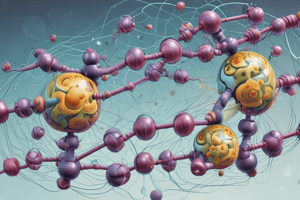Podcast
Questions and Answers
What does specific activity measure in an enzyme?
What does specific activity measure in an enzyme?
- The volume of the reaction
- The rate of reaction
- The moles of substrate converted per unit time
- The quantity of active enzyme present (correct)
How is enzyme activity defined?
How is enzyme activity defined?
- Rate multiplied by reaction volume
- Quantity of active enzyme present
- Total protein content present
- Moles of substrate converted per unit time (correct)
What is the purpose of differential centrifugation in protein extraction?
What is the purpose of differential centrifugation in protein extraction?
- To purify proteins based on solubility
- To track protein size using gel electrophoresis
- To recover a clean protein fraction (correct)
- To identify proteins using mass spectrometry
Which technique is commonly used to 'salt out' proteins during purification?
Which technique is commonly used to 'salt out' proteins during purification?
Why is it important to purify a protein?
Why is it important to purify a protein?
What is the basis of column chromatography separation?
What is the basis of column chromatography separation?
Which technique is commonly used in protein purification to separate proteins based on physical and chemical properties?
Which technique is commonly used in protein purification to separate proteins based on physical and chemical properties?
How does gel-filtration chromatography separate molecules?
How does gel-filtration chromatography separate molecules?
What is the primary goal in protein purification?
What is the primary goal in protein purification?
What is the primary purpose of mass spectrometry in proteomics?
What is the primary purpose of mass spectrometry in proteomics?
Which method is commonly used for determining the primary structure of proteins?
Which method is commonly used for determining the primary structure of proteins?
What technique is used to track protein activity after each purification step?
What technique is used to track protein activity after each purification step?
What is the purpose of raising antibodies in protein purification?
What is the purpose of raising antibodies in protein purification?
What is the purpose of N-terminal sequencing in protein identification?
What is the purpose of N-terminal sequencing in protein identification?
Which characteristic is NOT typically considered when determining protein purity?
Which characteristic is NOT typically considered when determining protein purity?
What does size-exclusion chromatography primarily separate based on?
What does size-exclusion chromatography primarily separate based on?
In which technique are proteins separated based on their size and charge?
In which technique are proteins separated based on their size and charge?
What is a common application of mass spectrometry in proteomics?
What is a common application of mass spectrometry in proteomics?
Which chromatography technique involves binding interactions for separation?
Which chromatography technique involves binding interactions for separation?
What is the significance of isoelectric focussing in protein analysis?
What is the significance of isoelectric focussing in protein analysis?
Which type of chromatography uses a gel material that doesn't interact with proteins?
Which type of chromatography uses a gel material that doesn't interact with proteins?
What is the main factor that determines the pore size in Size-Exclusion Chromatography?
What is the main factor that determines the pore size in Size-Exclusion Chromatography?
In Ion Exchange Chromatography, what type of molecules bind to negatively charged groups in the column resin?
In Ion Exchange Chromatography, what type of molecules bind to negatively charged groups in the column resin?
What happens to proteins with no net charge or a net negative charge in Ion Exchange Chromatography?
What happens to proteins with no net charge or a net negative charge in Ion Exchange Chromatography?
How are proteins eluted in Ion Exchange Chromatography after binding to the column resin?
How are proteins eluted in Ion Exchange Chromatography after binding to the column resin?
Which chromatography technique is based on interaction with overall charge and is less specific than affinity chromatography?
Which chromatography technique is based on interaction with overall charge and is less specific than affinity chromatography?
What is used as an eluent in cation exchange chromatography?
What is used as an eluent in cation exchange chromatography?
Which type of exchange chromatography binds proteins based on negatively charged groups?
Which type of exchange chromatography binds proteins based on negatively charged groups?
What is the role of Na+ ions in Ion Exchange Chromatography after proteins bind to the column resin?
What is the role of Na+ ions in Ion Exchange Chromatography after proteins bind to the column resin?
What is a characteristic of the gel material used in Size-Exclusion Chromatography?
What is a characteristic of the gel material used in Size-Exclusion Chromatography?
What does specific activity measure in an enzyme?
What does specific activity measure in an enzyme?
What is the purpose of differential centrifugation in protein extraction?
What is the purpose of differential centrifugation in protein extraction?
In column chromatography, which phase interacts with the samples to be separated?
In column chromatography, which phase interacts with the samples to be separated?
What is the primary goal of gel-filtration chromatography?
What is the primary goal of gel-filtration chromatography?
What is a common application of mass spectrometry in proteomics?
What is a common application of mass spectrometry in proteomics?
Which technique is commonly used to track protein activity after each purification step?
Which technique is commonly used to track protein activity after each purification step?
What happens in salting out during protein purification?
What happens in salting out during protein purification?
What does enzyme activity measure?
What does enzyme activity measure?
What is the basis of size-exclusion chromatography separation?
What is the basis of size-exclusion chromatography separation?
What is the role of N-terminal sequencing in protein identification?
What is the role of N-terminal sequencing in protein identification?
What is the primary reason for characterizing a protein?
What is the primary reason for characterizing a protein?
Which technique involves separating proteins based on their isoelectric points?
Which technique involves separating proteins based on their isoelectric points?
What is the main objective of protein purification according to the provided guidelines?
What is the main objective of protein purification according to the provided guidelines?
In protein purification, what is the purpose of developing analytical assays?
In protein purification, what is the purpose of developing analytical assays?
Which factor determines how pure a protein needs to be for therapeutic use in vivo studies?
Which factor determines how pure a protein needs to be for therapeutic use in vivo studies?
What method is commonly used for determining the primary structure of proteins?
What method is commonly used for determining the primary structure of proteins?
Which chromatography technique involves separating proteins based on their binding interactions?
Which chromatography technique involves separating proteins based on their binding interactions?
What is a common application of mass spectrometry in proteomics?
What is a common application of mass spectrometry in proteomics?
What is the primary purpose of using a gel material in Size-Exclusion Chromatography?
What is the primary purpose of using a gel material in Size-Exclusion Chromatography?
Which type of chromatography is less specific than affinity chromatography and relies on interactions based on overall charge?
Which type of chromatography is less specific than affinity chromatography and relies on interactions based on overall charge?
What happens to proteins that have a net positive charge in Ion Exchange Chromatography?
What happens to proteins that have a net positive charge in Ion Exchange Chromatography?
In Gel Filtration Chromatography, what role does the gel play in the separation process?
In Gel Filtration Chromatography, what role does the gel play in the separation process?
What is the primary function of raising antibodies during protein purification?
What is the primary function of raising antibodies during protein purification?
Which technique is typically used to separate proteins based on physical and chemical properties during purification?
Which technique is typically used to separate proteins based on physical and chemical properties during purification?
What is the main factor that determines the elution time of smaller molecules in Size-Exclusion Chromatography?
What is the main factor that determines the elution time of smaller molecules in Size-Exclusion Chromatography?
In Ion Exchange Chromatography, what happens when an excess of Na+ ions is added to the column?
In Ion Exchange Chromatography, what happens when an excess of Na+ ions is added to the column?
What characteristic of agarose, polyacrylamide, starch, or dextran makes them suitable for use in Size-Exclusion Chromatography?
What characteristic of agarose, polyacrylamide, starch, or dextran makes them suitable for use in Size-Exclusion Chromatography?
What is a common application of mass spectrometry in proteomics?
What is a common application of mass spectrometry in proteomics?
Flashcards are hidden until you start studying
Study Notes
Enzyme Activity
- Specific activity measures the number of moles of substrate converted per unit time per unit of enzyme, usually expressed as micromoles per minute per milligram of enzyme.
- Enzyme activity is defined as the rate of enzymatic conversion of substrate into product.
Protein Extraction
- Differential centrifugation is used to separate cell components based on their density and size, resulting in the separation of proteins from other cellular components.
Protein Purification
- Purification is necessary to remove contaminants, improve protein stability, and understand protein function.
- The primary goal of protein purification is to isolate a protein from its native source or a recombinant source.
Chromatography
- Column chromatography separates proteins based on their physical and chemical properties, such as size, charge, and binding affinity.
- Gel-filtration chromatography separates molecules based on their size, with smaller molecules eluting later than larger molecules.
- Size-exclusion chromatography separates based on the size of the molecule, with larger molecules being excluded from the gel matrix and eluting first.
- Ion Exchange Chromatography separates proteins based on their charge, with proteins binding to the column resin and eluting with a change in salt concentration or pH.
Protein Identification
- N-terminal sequencing is used to determine the primary structure of proteins.
- Mass spectrometry is used to determine the primary structure of proteins and identify protein modifications.
Protein Analysis
- Isoelectric focusing separates proteins based on their isoelectric points, which is the pH at which the protein has no net charge.
- Cation exchange chromatography binds proteins based on negatively charged groups, and anions are used as an eluent to elute bound proteins.
Protein Purification Techniques
- Salting out involves adding high concentrations of salt to a protein solution, causing proteins to precipitate out of solution.
- Affinity chromatography separates proteins based on specific binding interactions, such as antibody-antigen interactions.
- Gel material used in Size-Exclusion Chromatography is porous, allowing smaller molecules to enter the pores and be separated from larger molecules.
General
- The primary reason for characterizing a protein is to understand its function and biological role.
- Developing analytical assays is necessary to track protein activity during purification and to validate protein purity.
Studying That Suits You
Use AI to generate personalized quizzes and flashcards to suit your learning preferences.





